The ecosystem approach to fisheries (EAF) in its links with food security in the spotlight
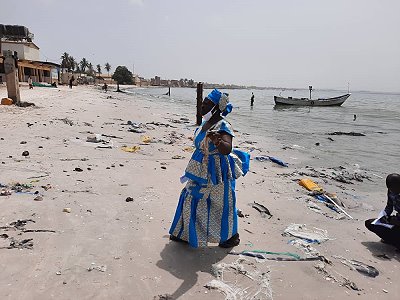
Madame Mané in awe of the garbage on the beach
The Hann Montagne school has opted for the 2021 edition of World Oceans Day (WOD) for an excursion for students aged between 11 and 12 years of age, on June 9, 2021, to the artisanal fishing landing site in Hann with the ruler showing the minimum sizes of sexual maturity of the main commercial fish species. This choice is inspired by the teaching kit developed by Mundus maris with and for the FAO EAF Nansen Programme, an initiative in which schools in Hann had participated.
The idea for an educational outing using the fish ruler was chosen by the teaching staff during a preparatory meeting at the school, 25 May 2021, with Aliou Sall chaired by the director, Ms Sané. The main reason is linked to the issue of food security becoming an issue in the community.
Indeed, Mr. Ndiaye - having already participated in a seminar to upgrade teachers on the ecosystem approach to fisheries at the initiative of Mundus maris - underlined the importance for young students, the overwhelming majority of whom come from fishing families.
In the current fishing context, the marketing of juveniles is frequently observed in small markets at the street corners in the community. Thus repercussions on the future of the resource and food security are to be feared. The director had underlined that failure to respect the minimum size has a direct impact on the increase in the price of fish that have become rarer and that is already felt in the "housewife's basket".
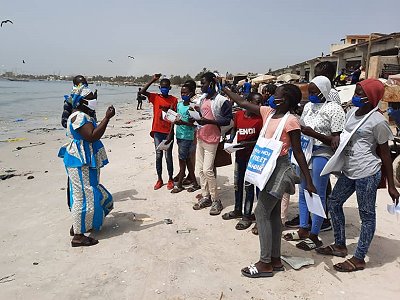
Ms. Mané and Mr. Ndiaye question the students on the beach, beach of Hann Bay
The excursion was organised with around ten students, half of them girls and boys. The pedagogical framing was ensured by Ms. Mané and Mr. Ndiaye, their school teachers, and Aliou Sall from Mundus maris as an expert accompanied by Mr. Souleymane Sow, volunteer of Mundus maris.
Supervised by the two teachers, the students had equipped themselves with the fish ruler and each with a notebook and a pen for the purpose of reporting back in class to the teachers and other students.
At first, as soon as the students arrived on the fish landing place, they were imrpessed - as were the two teachers - by the dirty condition of the beach, with plastic waste thrown back by the sea and garbage from households bordering the Bay of Hann.
This is how an observation course was improvised right on the beach. On the basis of questions and answers, for an hour and a half Mr. Ndiaye and Ms. Mané brilliantlyanimated this session. As the images taken during this observation session illustrate, the students took a lot of notes which were then reported back to class.
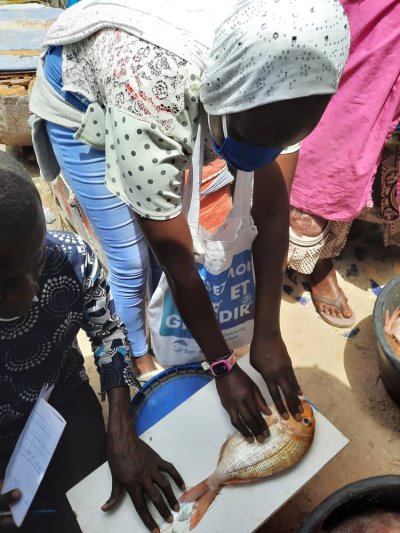
Measurement of a sea bream, found to be a good size
Thanks to the approach of the two teachers, this session allowed the students to realize that there are several factors behind the pollution of the ocean and coastal areas and the resulting impacts. Indeed this is the first opportunity that was offered to these students to understand that the responsibilities must be shared between the political decision makers at the national level, the local elected officials in charge of the living environment in the municipality in charge of their school, but also the residents who contribute significantly to the pollution of the bay. They thus realized that ocean pollution has very negative impacts on public health.
They were also able to understand the link with food security, because if fish habitats are polluted, there are fewer fish and the living conditions of people who depend on fishing experience a decline in their income, especially as the resources are already in an overfished condition. These multiple sources of stress on the fish resources and their ecosystems are felt everywhere.
It was at the end of this first exercise that the fish measurement session started at the stalls of the fishmongers found on the spot and who showed an excellent spirit of cooperation.
The measurement session was preceded by a presentation of the reasons for the trip by Aliou Sall for the wholesalers. He took the opportunity to tell them about World Oceans Day, its merits and the theme of the 2021 edition "The Ocean: Life and Livelihoods". He also explained in detail the meaning of the fish ruler and what is meant by the minimum length of sexual maturity.
The wholesalers with whom the excursion team worked expressed great curiosity about the fish ruler they had only just discovered during the session. They were all the more impressed - but above all surprised - to hear what the size of sexual maturity means and especially understand the negative impact on the availability of the resource if these minimum sizes are not respected. That certainly fostered their interest and their collaboration, thus contributing to the success of the field trip.
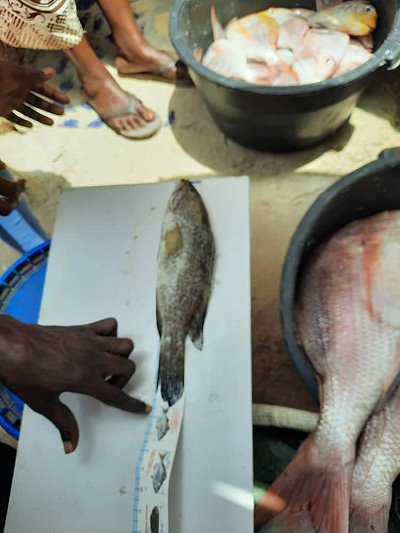
Measurement of a miserable white grouper of approximately 30 cm which should have measured at least 60 cm!
The students thus proceeded to measure the different species found that day on the landing site, in particular grouper, sea bream and sardinella. While awaiting the students' report in collaboration with their teachers, the main lessons learned from this outing dedicated to the ecosystem approach to fisheries are as follows
(i) the juvenile groupers dominate by far the marketed quantities (for this emblematic species in Senegal). The sizes rarely exceeded 25 cm while the mimimum size of a white grouper ('thiof' in Wolof, Epinephelus aeneus) is around 60 cm total length!
(ii) the sea breams found in the landing area were all of good sizes beyond minimal length. They were fished in Mauritanaian waters and landed in Hann transiting through Saint Louis in the north of Senegal.
(iii) the round sardinellas (Sardinella aurita) had achieved the minimum total length of about 20 to 23 cm, but the men and women fishmongers cautioned that in living memory this was the worst fishing season. They noted that the sardinella season had started too late and lasted for at best three months instead of seven to eight months!
It should also be noted that in the review meeting afterwards and in the light of the rich lessons learned from the excursion, the teaching staff, under the supervision of the director, expressed the need for a sustained partnership with Mundus maris. This would not only consolidate the achievements, but also allow the school to develop this initiative further given that the students mainly come from fishing families.
Some proposals have already been outlined in the perspectives of such a more continuous collaboration. They will be better structured in order to be able to share them with Mundus maris.
But in the meantime, the school would like to have a set of fish rulers for the students and any other support materials that can help them to continue working on the ecosystem approach to fisheries.
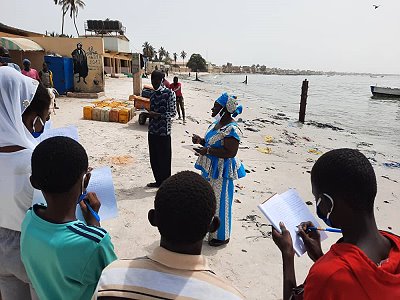 |
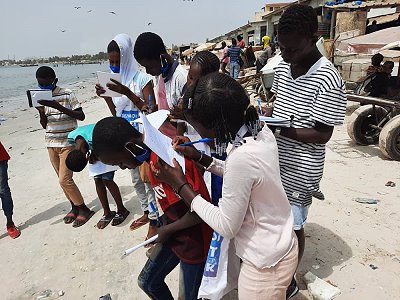 |
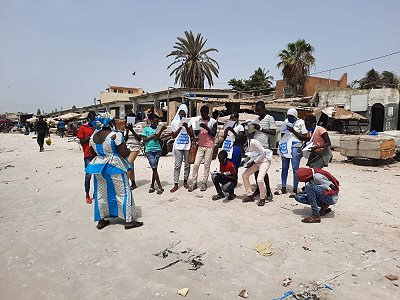 |
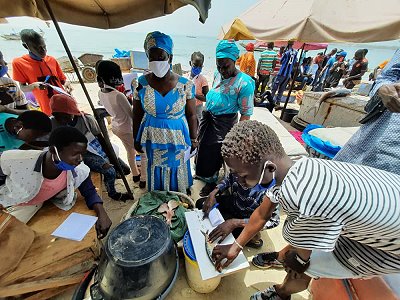 |
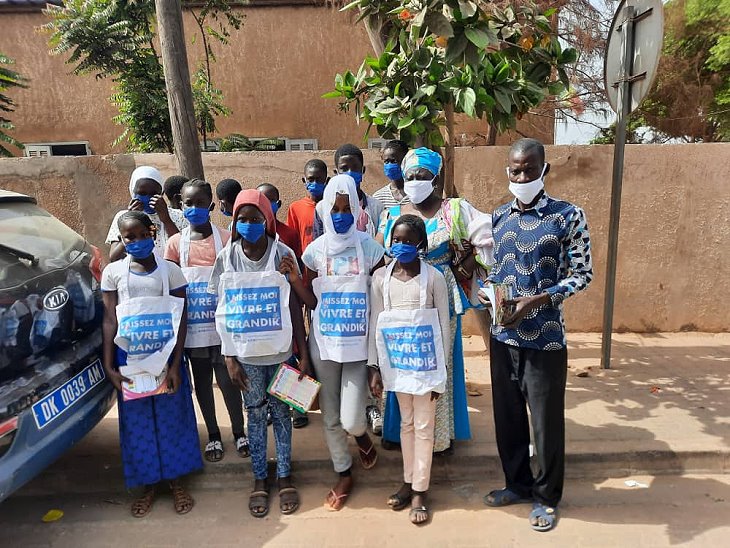
Text and photos by Aliou Sall









